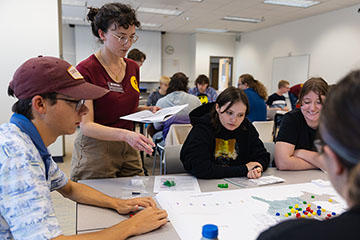A unique look into Alzheimer’s disease
CMU researcher probes root causes in quest for new treatments
Alzheimer's disease affects more than 6 million Americans and their families. And while countless scientists study it, Central Michigan University psychology faculty member Kevin Park's research is unique to his lab.
Using a genetic model he developed, Park is probing the earliest indicators of the disease, before symptoms appear, in a search for effective treatments.
"We still don't know what causes Alzheimer's disease, and that's the challenge," said Park, who also is part of CMU's interdisciplinary neuroscience and biochemistry, cellular and molecular biology programs.
While heredity makes a small percentage of people susceptible to Alzheimer's, 95% of cases seem to occur randomly.
Park said those random cases account for the bulk of clinical evaluations and studies of Alzheimer's disease progression. But when researching the disease mechanisms, most scientists study the hereditary disease models.
Park focuses instead on the 95%.
Going upstream
Park said most Alzheimer's disease research centers on the symptoms seen in later stages rather than the early triggers.
With funding from the National Institutes of Health, he's focusing on the "upstream process" — what happens to initiate the disease? He said it's a bit like learning the reasons behind the current new car shortage.
"You can have a car and happily drive it around, but if you know how to make a car — the upstream process — then you understand what the key parts are," he said.
"If cars are not being produced and you don't know the upstream process, it's hard to understand why there might be a backlog. But now people are like, 'well, there's a computer chip shortage, which is critical for cars.'"
In other words, Park said, understand the process and you probably can tap into it and fix problems early on.
A unique approach
Park is focusing now on a process called neuronal cell cycle re-entry.
Neurons, unlike most other types of cells, don't replace themselves through cell division — they last for a person's lifetime. In early Alzheimer's disease, though, neuron cells are not dividing, yet chemical markers associated with cell division begin to appear. These markers may have adverse impacts that are not yet well understood. They might kill cells or cause Alzheimer's, Park said.
This is where Park's genetic model comes in. It's a type of mouse bred specially to carry these chemical markers. His latest research, published June 28 in the Journal of Alzheimer's Disease, crossed those mice with other mice whose brains accumulate amyloid-beta, a protein fragment associated with Alzheimer's. Their offspring developed several of the same conditions found in the brains of people with Alzheimer's.
It's a significant finding because, even though amyloid-beta is the subject of much Alzheimer's research, it doesn't appear to cause the disease on its own.
"There are people who can have amyloid-beta and be cognitively unimpaired," Park said. "My model is looking at the non-amyloid-beta aspects of the disease."
Crunching the numbers
Park is collaborating with researchers from other institutions and talking with bioinformatics experts who can process the big data involved in interpreting thousands of chemical interactions in the brain.
They'll look for unique features, processes and pathways that new drugs could target.
"You let the data lead you," he said. "The goal is to understand the disease and then to target those processes to delay or stop the disease. That is the ultimate goal."




